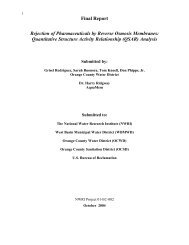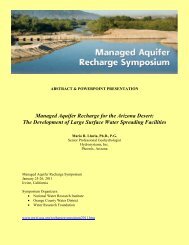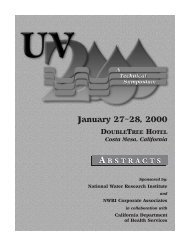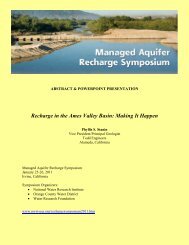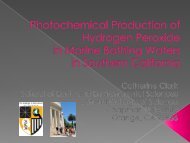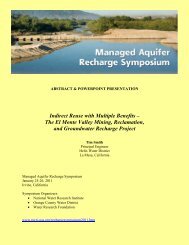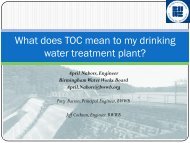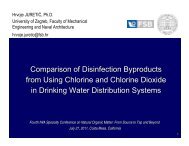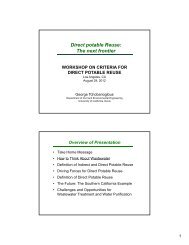RBF_Cover (for eps) - National Water Research Institute
RBF_Cover (for eps) - National Water Research Institute
RBF_Cover (for eps) - National Water Research Institute
You also want an ePaper? Increase the reach of your titles
YUMPU automatically turns print PDFs into web optimized ePapers that Google loves.
Session 4: Siting<br />
<strong>Water</strong>-Quality Management <strong>for</strong> Existing Riverbank-<br />
Filtration Sites along the Elbe River in Germany<br />
Prof. Dr.-Ing. Thomas Grischek<br />
University of Applied Sciences Dresden<br />
Dresden, Germany<br />
Introduction<br />
In <strong>for</strong>mer times, the management of <strong>RBF</strong> sites in Germany focused on water quantity — how much<br />
water could be abstracted and what groundwater levels would result. Control measures were based<br />
on measurements of river and groundwater levels and pumping rates and on black-box models to<br />
estimate the portion of riverbank filtrate abstracted (e.g., Luckner and Nestler, 1982). The<br />
development of computer programs <strong>for</strong> groundwater flow and transport simulations resulted in<br />
increasing management applications <strong>for</strong> <strong>RBF</strong> sites (e.g., Koster et al., 1994; Heinzmann, 1998;<br />
Eckert et al., 2000).<br />
The number of published papers dealing with the complex management of water quality at <strong>RBF</strong><br />
sites is very low. Besides work done by Sontheimer (1991) and Schubert (1999) at sites along the<br />
Rhine River, a control and management concept <strong>for</strong> the Hengsen site on the Ruhr River<br />
(Schöttler and Sommer, 1992) must be highlighted. At the end of the 1980s, water-quality<br />
management also became a subject <strong>for</strong> <strong>RBF</strong> sites on the Elbe River due to problems with river and<br />
raw-water quality. Initial work done by Müller, Schwan, and others between 1985 and 1989 was<br />
continued by Nestler et al. (1998).<br />
<strong>Water</strong>-quality management must be based on detailed knowledge of groundwater flow conditions<br />
and monitoring measures to obtain sufficient data on water quality; however, this is not the case<br />
<strong>for</strong> every site. Of course, <strong>for</strong> small waterworks, such investigations and investments may be higher<br />
than the cost savings resulting from water-quality management. But, the optimization of water<br />
abstraction can have long-term effects on raw-water quality and treatment cost savings. <strong>Water</strong>quality<br />
management systems are well established at sites where problems with contamination have<br />
occurred (e.g., high concentrations of nitrate, organic halogens). In such cases, experiences may<br />
not be published to give the impression of a “no problem waterworks” or because a clear<br />
description is not easy due to the large amount of data needed to understand the complex system<br />
and site-specific boundary conditions.<br />
General <strong>Water</strong>-Quality Management Measures<br />
The first step in water-quality management is to clarify which advantage of <strong>RBF</strong> is the most<br />
important and to identify the main aims or problems. At one site, the nitrate concentration in the<br />
raw water should be decreased; at another site, the concentration of DOC, dissolved iron, or an<br />
organic contaminant should decrease.<br />
Correspondence should be addressed to:<br />
Prof. Dr.-Ing. Thomas Grischek<br />
Professor<br />
<strong>Institute</strong> <strong>for</strong> Geotechnics & <strong>Water</strong> Sciences<br />
University of Applied Sciences Dresden • Friedrich-List-Platz 1 • 01069 Dresden, Germany<br />
Phone: +49 351 4623350 • Fax: +49 351 4623567 • Email: grischek@htw-dresden.de<br />
63



